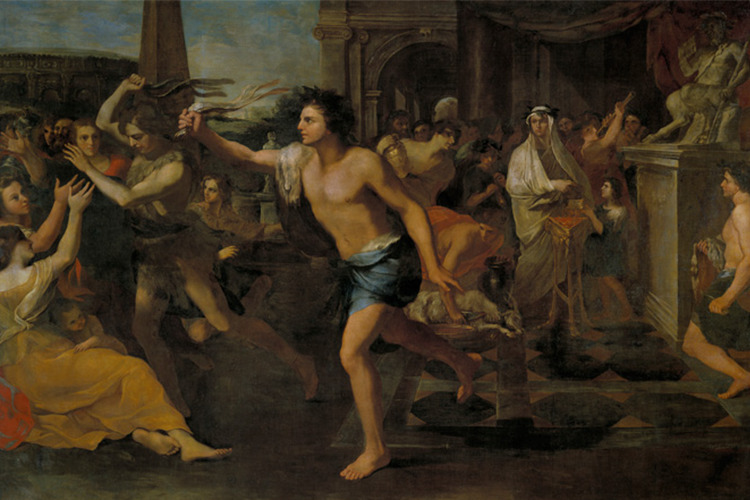
A painting depicting the festival of Lupercalia , a festival that is thought to be one of the many speculated origins of Valentine's Day. painting by Andrea Camassei
This modern holiday of Valentine’s Day has a unique and ancient history.
Often associated with love letters, chocolates, and red and pink decorations, Valentine’s Day is a day celebrated by millions of people. As a holiday that’s celebrated every year, one can’t help but wonder about its origins.
The modern Valentine’s Day is speculated to have links to the ancient Roman holiday of Lupercalia. The festival of Lupercalia was held on the 13th of February through the 15th of February, meant to bring good health and fertility, while also purifying the city. This can be shown in the modern holiday, with the latin root “valens,” meaning “good health.” This festival included sacrifices meant to be an homage to the mythical founders of Rome, Romulus and Remus, and the she-wolf that had nursed them. Because of this, it is believed that Lupercalia had been celebrated since the founding of Rome, in the 6th century BCE. This holiday had been celebrated until the 5th century CE, where Pope Gelasius had eliminated the practice and instead declared the 14th of February as a holiday to celebrate the martyrdom of Saint Valentine.
Well, who exactly was Saint Valentine? According to different sources, his existence is debated. He was either a Roman Priest or possibly a Bishop from Terni Italy. However, both were described as Patron Saints of Love. Priest Valentine of Rome was executed for conducting marriages in secret. The Emperor Claudius II had wanted more soldiers for the Roman Empire’s army, so he outlawed marriage for young couples. His reasoning? Young men would make better soldiers because they don’t have wives or a family to be attached to. Priest Valentine of Rome had found this outrageous and started officiating the weddings of young couples in secret. Eventually he was found out, and was jailed, sentenced to execution. While imprisoned he fell in love with the jailer’s daughter, he sent her a love letter signed “From your Valentine” before his untimely brutal decapitation.
The Bishop Valentine of Terni was a miracle worker that was sent to Rome to cure a child of a Prominent Roman official. Surprisingly the Family of the Roman official had all converted to Christianity shortly afterward. He was then sentenced to execution, which then resulted in his untimely brutal decapitation. There are many theories about Saint Valentine. Some say that the Priest of Rome and Bishop of Terni were the same person, others say that he was two different people, and some say he was never martyred and instead had funded construction projects in the region. Either way, Saint Valentine had a huge impact.
When the holiday was first announced by the Pope Gelasius, it wasn’t celebrated as a day of love, it instead was meant to honor the martyrdom of Saint Valentine. However, later in the Middle Ages, specifically in France and England, it was commonly believed that the 14th of February was the start of the bird’s mating season, and therefore added to the notion that the holiday should be associated with love. English Poet Geoffrey Chaucer was the first to record the holiday as being a romantic one, by associating it with the bird’s mating season in his poem The Parliament of the Foules. “For this was on Saint Valentine’s day/ When every fowl comes there his mate to take.” As the romantic interpretation of the holiday became more and more popular throughout Medieval Europe, so did the creation of Valentine’s day cards. The world’s oldest valentine’s day card was made by Chalres, A duke of Orleans, using valentine as a term of endearment to his wife Bonne of Armagnac. This card was more of a letter, and written during his imprisonment in the London Tower after being captured by the English during the Battle of Agincourt. His letter translates to “I am already sick of love, My very gentle Valentine.” Unfortunately Bonne had died before she had received the letter.
In the 18th century, it became more common for gifts to be exchanged between both lovers and friends during the holiday. These gifts were mainly cards with elaborate designs and decorations, usually ribbons and lace. In the 1840s, Esther A. Howland, “Mother of the Valentine,”is an artist and entrepreneur credited with the popularization of mass produced valentines day cards in the United States. With the evolution of postage systems and shipping, sending cards by mail contributed to the popularity of Valentine’s day cards.
In the United States, Valentine’s Day includes decorations, chocolate, and gift giving. In the Philippines, Valentine’s Day celebrations include a government sponsored Gala event, trying to get young couples to get married, making February 14th the most common wedding anniversary in the country. Ghana is one of the most cocoa bean producing countries in the world, and therefore named February 14th “National Chocolate Day.” The nation of Estonia instead celebrates National Friendship Day, mostly as an alternative for those who have yet to find a romantic partner. With such a violent history, from the ancient Romans, to the martyrdom of Saint Valentine, it’s reassuring that today’s Valentine’s Day celebrations are happy ones, no matter the country.
Click here to read a related article about the commercialization of Valentine’s Day.